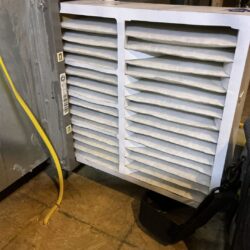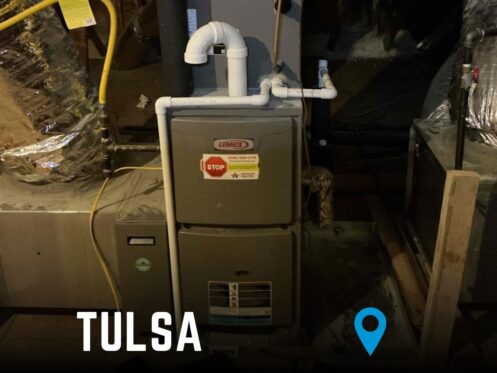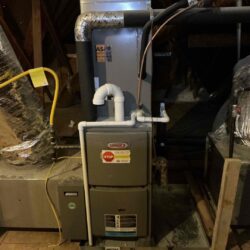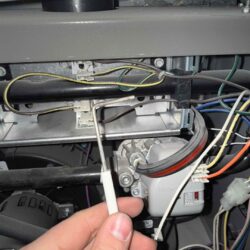When a furnace kicks on and rattles the whole house, it’s more than just annoying—it’s a sign something isn’t secure, aligned, or operating as designed. This case study walks through a recent call for furnace Repair in Tulsa, OK, where a homeowner heard a persistent rattling noise at startup. We’ll show how we diagnosed the issue step-by-step, what ultimately fixed the sound, and how Tulsa homeowners can prevent this problem before winter temperatures drop.
Today, you’ll learn the common causes of furnace rattles—from loose panels and blower wheels to duct resonance and, in rare cases, heat exchanger concerns—and how we isolate each possibility safely and efficiently. We’ll also cover what the repair entailed, how long it took, and what it typically costs in Tulsa so you know what to expect when you schedule furnace Repair in Tulsa, OK.
What a Rattling Furnace Noise Usually Means
A rattling sound at startup is one of the most common furnace complaints, and the causes often come down to vibration, loose hardware, or components that are just slightly out of alignment. Because the blower ramps up quickly, anything that’s not snug can buzz, rattle, or chatter until airflow and speed stabilize. While many fixes are minor, leaving the issue unchecked can lead to premature wear, reduced efficiency, and—on rare occasions—safety concerns.
For homeowners seeking furnace Repair in Tulsa, OK, early diagnosis is your best defense. Catching a rattle when it starts is far less costly than waiting until a blower wheel cracks, a motor mount fails, or a duct joint separates. Below are the most common sources we investigate and the signs that point us in the right direction.
Loose Panels, Screws, or Blower Housing Vibrations
The simplest culprit is often the right one: cabinet panels or access doors that aren’t fully latched. Even a millimeter of play can cause a metal-on-metal buzz as the blower kicks on. Over time, routine filter changes or seasonal expansion and contraction can loosen screws and clips, turning gentle vibration into an audible rattle.
We also look closely at the blower housing and nearby brackets, which can resonate like a drum if fasteners back out. Re-seating panels, replacing missing screws, and adding vibration-damping pads where metal meets metal usually yields an instant reduction in noise. This quick fix is a common outcome for furnace Repair in Tulsa, OK, especially in systems that haven’t had a tune-up in the last season.
Blower Wheel or Motor Issues (Wobble, Bearings, Mounts)
If the sound is louder during the first seconds of startup and then fades, the blower wheel or motor could be slightly off-balance. A loose set screw on the blower wheel hub can cause the wheel to shift on the shaft, creating a telltale rattle that improves as speed evens out. Likewise, a bent fin or accumulated debris on the wheel can throw it off balance.
Motor bearings and mounts are another frequent source. Worn bearings may produce a rattle that evolves into a hum or grind, while fatigued motor mounts allow the assembly to vibrate against the housing. Addressing these issues early prevents collateral damage to the motor, control board, and housing—one of the biggest money-savers in proactive furnace Repair in Tulsa, OK.
Ductwork Expansion, Loose Runs, or Resonance
Ductwork naturally expands and contracts with temperature changes, but loose takeoffs, unbraced runs, or flimsy transitions can turn normal expansion into a rattling chorus. If the noise seems to come from a nearby wall, ceiling, or return grille rather than the furnace cabinet, duct resonance may be to blame.
Strategic reinforcement—adding screws, mastic, foil tape, or strapping—can quiet things down dramatically. In some homes, adding lined duct sections or isolation connectors near the air handler helps absorb vibration before it travels through the duct system. This not only reduces noise but also improves airflow and system efficiency.
Heat Exchanger Concerns and When to Be Cautious
While less common, a damaged or cracked heat exchanger can create unusual sounds, including metallic rattles or pings. This is a serious scenario because compromised heat exchangers can leak combustion byproducts into the airstream. If we suspect exchanger issues—often signaled by soot, flame disturbance, or abnormal odors—we stop and perform a thorough safety evaluation.
When in doubt, shut the system down and call a professional. Safety takes priority, and an expert evaluation will confirm whether the sound is benign vibration or something requiring immediate repair or replacement. If you’re unsure, err on the side of caution and schedule furnace Repair in Tulsa, OK as soon as possible.
Transitioning from the common causes, let’s look at the specifics of this Tulsa call—what the homeowner experienced, what we observed on arrival, and the clues that guided our diagnosis.
The Tulsa Call: A Quick Overview of the Customer’s Issue
The homeowner reported a sharp rattling noise that began the moment the furnace started and persisted for roughly 20–30 seconds before tapering off as airflow stabilized. They noticed the sound was strongest near the furnace cabinet and adjacent return, with a faint vibration felt through the nearby hallway wall. Importantly, the system still produced heat and didn’t trip any safety switches, but the startup rattle had grown louder over the past two weeks—especially during early morning cycles when the house was cooler.
On arrival, we found a moderately dirty 1-inch filter, which can contribute to turbulence and vibration, and a cabinet access panel with a slightly loose latch. The homeowner mentioned recent high winds and dust, plus no maintenance since last heating season. Visual clues suggested a likely combination: minor cabinet vibration and a possible blower wheel imbalance that showed up most noticeably at startup speed. With those observations in mind, we proceeded with a systematic diagnosis to confirm the source and ensure safe, reliable furnace Repair in Tulsa, OK.
Because rattles can mask more serious problems, we never assume it’s “just a panel.” The next step was to isolate the noise with the system safe-off, then replicate startup conditions to pinpoint the component responsible. With safety checks complete, we moved into our step-by-step diagnostic process for furnace Repair in Tulsa, OK.
Our Diagnostic Process for Furnace Repair in Tulsa, OK
With the homeowner’s observations noted, we began a structured diagnostic to pinpoint the rattle and rule out safety concerns. A methodical approach prevents guesswork, ensures accurate repairs, and helps Tulsa homeowners avoid repeat issues.
Each step builds on the last: we start with safety, then recreate the symptom, test hypotheses, and verify system performance. This consistent process is the backbone of dependable furnace Repair in Tulsa, OK.
Safety First: Power Off, Gas Safety Check, and CO Detector Status
Before touching components, we shut off electrical power to the furnace and verified gas shutoff accessibility. We also confirmed clear venting and looked for soot, scorch marks, or unusual odors around the combustion compartment—red flags that would change the course of the visit.
We checked the home’s carbon monoxide detectors for proper placement and battery status. Even when a rattle seems minor, ensuring safe operation is non-negotiable and keeps your family protected throughout the diagnosis.
Replicate the Noise and Localize the Source
We re-energized the system and triggered a call for heat to replicate the startup rattle. Using a mechanic’s stethoscope and careful hand placement (never near moving parts), we listened for where vibration peaked—cabinet, blower housing, or duct transitions.
The sound intensity was strongest at the lower cabinet near the blower compartment. The noise quickly diminished as the blower reached steady speed, a classic sign pointing toward blower wheel balance, mounting, or nearby panel resonance.
Inspect Panels, Fasteners, Blower Compartment, and Motor Mounts
With power off again, we removed the access panels and inspected all cabinet screws, clips, and grommets. We found a slightly loose latch on the blower access door and two cabinet screws that had backed out.
Inside the blower compartment, we checked the motor mounts and housing. One mount had minor play, enough to allow startup vibration to transmit to the cabinet, amplifying the rattle.
Check Blower Wheel Balance and Set Screw; Measure Static Pressure
We examined the blower wheel for debris, bent fins, or set-screw looseness on the motor shaft. The hub’s set screw was snug but not fully torqued, and we noticed a light dust accumulation on the wheel that could contribute to imbalance.
We also measured external static pressure to ensure airflow conditions weren’t stressing the blower. The reading was slightly elevated, consistent with a moderately dirty filter, which can worsen vibration and startup noise.
Inspect Duct Connections, Transitions, and Return Air Cavities
Next, we looked at the return drop and supply plenum transitions for loose seams or thin metal that could resonate at ramp-up. One return transition had minimal bracing and showed minor flex when the blower started.
We verified screws at key joints and applied light pressure during a test start to confirm the rattle’s response. With reinforcement planned, we had high confidence we could quiet this furnace quickly and effectively.
Evaluate Heat Exchanger and Combustion Area Indicators
Although no symptoms pointed directly to combustion issues, we visually inspected for flame disturbance, unusual odors, or heat exchanger indicators. Everything appeared normal, supporting the diagnosis of mechanical vibration rather than a combustion-related concern.
With the primary noise sources identified, we moved forward with targeted repairs to stop the rattle and stabilize startup operation.
The Fix: How We Stopped the Rattle
Once we isolated the sources, the solution involved tightening hardware, correcting minor alignment, and reinforcing a vibrating transition. Addressing all contributing factors ensures the rattle doesn’t migrate or return.
We also completed a performance verification to confirm quiet startup, proper airflow, and safe operation. This is a standard step in our furnace Repair in Tulsa, OK service visits.
Tightening and Re-securing Panels, Brackets, and Hardware
We re-seated and tightened the blower access door, replaced two cabinet screws, and added vibration-damping pads where metal contacted metal. This immediately reduced cabinet resonance during ignition and early blower ramp-up.
We also snugged up brackets around the blower housing to limit flex. A few small adjustments to how the panel sat in its channel eliminated the buzzing edge contact that had contributed to the audible rattle.
Balancing/Reseating or Replacing the Blower Wheel; Motor Mount Adjustments
We cleaned the blower wheel to remove dust buildup and re-torqued the hub set screw to spec. This restored balance and prevented the wheel from shifting microscopically on the shaft during startup.
The motor mount with minor play was adjusted and secured. Tight, aligned mounts dramatically reduce vibration transfer to the cabinet and extend the life of the motor and bearings.
Duct Reinforcement and Vibration Damping Where Needed
We reinforced the return transition with additional screws and a small brace to prevent thin-metal “drumming.” Where appropriate, we used foil tape and mastic to secure seams and minimize future movement.
In homes with especially lively ductwork, we sometimes add an isolation connector near the air handler. This customer didn’t require it after the other corrections, as the resonance disappeared.
Final Test Run: Quiet Startup, Stable Operation, and Airflow Verification
After reassembly, we installed a fresh filter, verified proper airflow, and ran multiple heat cycles. Startup was nearly silent, with no rattle or buzz through the wall and a smooth ramp to steady speed.
We rechecked external static pressure and confirmed it returned to an acceptable range. The system heated as designed, with even airflow and no signs of mechanical or combustion abnormalities.
With the rattle resolved, the next question most Tulsa homeowners ask is, “What does this usually cost, and how long does it take?”
Costs and Timelines in Tulsa: What to Expect
For furnace Repair in Tulsa, OK, most rattling-noise visits begin with a diagnostic that typically takes 45–90 minutes. This covers safety checks, noise replication, localization, and component inspection, plus a clear explanation of findings.
Pricing depends on what’s discovered. Many rattles are cured with tightening, balancing, minor adjustments, or duct reinforcement—relatively affordable fixes. Costs increase if parts are worn or damaged (e.g., blower wheel replacement, motor mounts, or a new motor). We always seek the least invasive solution that keeps you safe and comfortable.
You can expect transparent recommendations, written estimates, and your approval before we proceed with repairs. If parts are on-hand, most fixes are completed same day; special-order parts may add 1–2 business days. Emergency furnace Repair in Tulsa, OK is often available during peak cold snaps to restore heat and safety fast.
Safety Notes: When a Rattle Could Signal a Hazard
While most rattles are mechanical vibration, some noises hint at risk. Treat unusual sounds seriously, especially if they appear suddenly, grow louder, or are accompanied by other symptoms.
If you notice any of the following, shut the system down and call a professional immediately:
- Metallic clanking or scraping that continues beyond startup
- Burning or chemical odors, visible soot, or discoloration near the burner area
- Frequent short cycling, flame disturbance, or the furnace struggling to stay on
- Carbon monoxide detector alarms or headaches/nausea in the home
Install CO detectors on each level of your home and near sleeping areas, test them monthly, and replace batteries as recommended. When in doubt, it’s safer to stop operation and schedule an expert assessment for furnace Repair in Tulsa, OK.
Preventive Maintenance Checklist for Tulsa Homeowners
Quiet, efficient operation is the result of small habits practiced consistently. A few preventive steps reduce the chance of surprises and extend the life of your system.
Before the first cold snap, schedule a professional tune-up. During the season, change or clean filters on schedule (often every 1–3 months for 1-inch filters), and keep returns clear of furniture and dust.
Use this quick checklist to stay ahead of noise:
- Tighten cabinet panels and verify access door latches after filter changes
- Inspect blower assembly for debris and ensure the wheel is clean and secure
- Check duct connections for loose seams; reinforce thin or vibrating transitions
- Keep the furnace area clean and free from stored items that can rattle or restrict airflow
- Replace filters on time and track dates so airflow stays stable
Staying proactive with maintenance significantly reduces the odds you’ll need urgent furnace Repair in Tulsa, OK during the coldest nights.

FAQs About Furnace Repair in Tulsa, OK
Why does my furnace rattle only at startup?
Startup is when the blower accelerates from zero to operating speed, and that rapid change amplifies any looseness or imbalance. Slightly loose panels, a blower wheel that isn’t perfectly secured, or thin duct transitions often rattle only during this ramp-up phase.
As speed stabilizes, vibration can settle, masking the underlying cause until it worsens. Early attention prevents a minor rattle from turning into a broken wheel, stressed motor, or separated duct seam.
Is it safe to keep running a rattling furnace?
If the rattle is mild and you’re not noticing other symptoms—odors, soot, short cycling—it may be safe short-term. However, vibration accelerates wear and can escalate into costlier repairs if ignored.
For peace of mind and to protect your equipment, schedule timely furnace Repair in Tulsa, OK. A quick tune and tightening now usually costs far less than a major component failure later.
How fast can you come out in Tulsa, and do you offer emergency service?
Many local providers offer same-day or next-day appointments, with emergency service during peak cold snaps. Availability varies with weather and demand.
If your furnace is rattling loudly, won’t stay on, or triggers a CO alarm, shut it down and request an urgent visit. Clear notes about the noise and when it occurs help techs resolve the issue faster.
Do you service all furnace brands and fuel types?
Our Team services most major brands and both gas and electric furnaces. Parts availability can influence turnaround time, especially on older units or specialty models.
When you schedule furnace Repair in Tulsa, OK, share your brand, model, and any previous repairs. These details help ensure the right parts and tools are ready on arrival.
Will this affect my utility bill or system lifespan?
Yes—vibration and imbalance reduce efficiency and strain components. A rattling blower can cause higher static pressure, wasted energy, and premature wear on motors and bearings.
Eliminating the rattle improves airflow, lowers stress, and helps your furnace run closer to its designed efficiency, supporting a longer, quieter service life.



